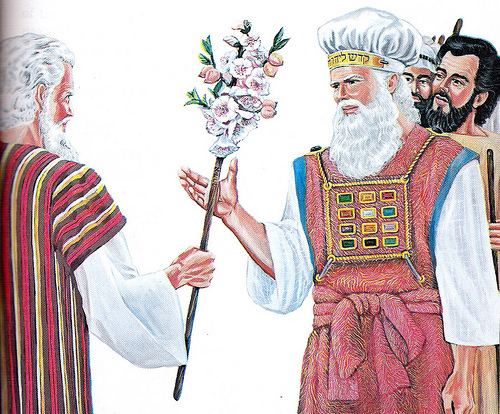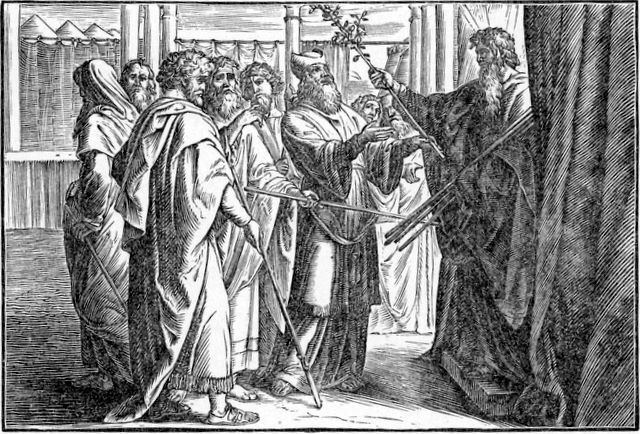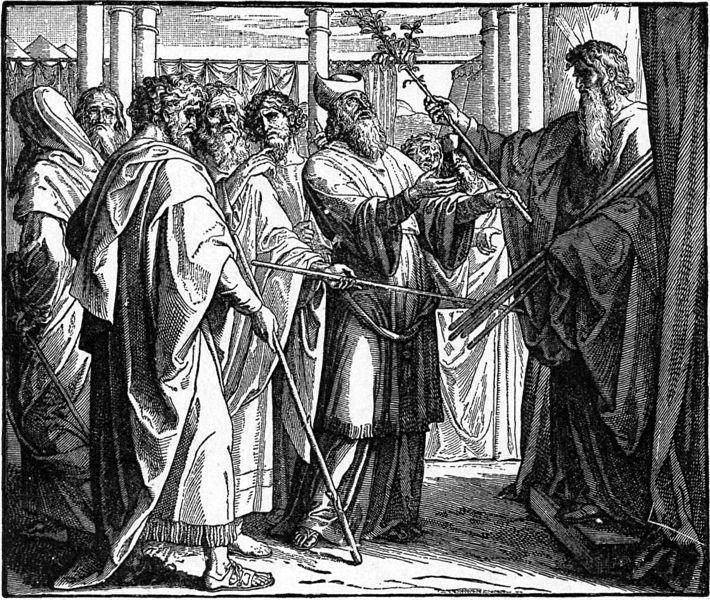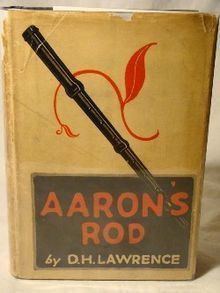 | ||
Similar Golden calf, Matzevah, Jacob's Ladder | ||
Aaron's rod refers to any of the staves carried by Moses's brother, Aaron, in the Torah. The Bible tells how, along with Moses's rod, Aaron's rod was endowed with miraculous power during the Plagues of Egypt that preceded the Exodus. There are two occasions where the Bible tells of the rod's power.
Contents
- Numbers 17 18 aaron s rod
- In Rabbinical literature
- Haggadic modification
- Christian use
- In modern literature
- References
Numbers 17 18 aaron s rod
In Rabbinical literature

The Bible ascribes similar miraculous powers to the Rod of Aaron and to the staff of Moses (compare, for example, Exodus 4:2 et seq. and 7:9). The Haggadah goes a step further, and entirely identifies the Rod of Aaron with that of Moses. Thus, the Midrash Yelammedenu states that:

the staff with which Jacob crossed the Jordan is identical with that which Judah gave to his daughter-in-law, Tamar (Genesis 32:10, 38:18). It is likewise the holy rod with which Moses worked (Exodus 4:20, 21), with which Aaron performed wonders before Pharaoh (Exodus 7:10), and with which, finally, David slew the giant Goliath (I Samuel 17:40). David left it to his descendants, and the Davidic kings used it as a scepter until the destruction of the Temple, when it miraculously disappeared. When the Messiah comes it will be given to him for a scepter in token of his authority over the heathen.

It was made of sapphire, weighed forty seahs (a seah = 10.70 pounds), and bore this inscription דצכ עדש באחב, which is composed of the initials of the Hebrew names of the Ten Plagues (Tan., Waëra 8, ed. Buber).
Haggadic modification
Legend has still more to say concerning this rod. God created it in the twilight of the sixth day of Creation (Pirkei Avoth 5:9, and Mekhilta, Beshallaḥ, ed. Weiss, iv. 60), and delivered it to Adam when the latter was driven from paradise. After it had passed through the hands of Shem, Enoch, Abraham, Isaac, and Jacob successively, it came into the possession of Joseph. On Joseph's death the Egyptian nobles stole some of his belongings, and, among them, Jethro appropriated the staff. Jethro planted the staff in his garden, when its marvelous virtue was revealed by the fact that nobody could withdraw it from the ground;(the sword in the stone) even to touch it was fraught with danger to life. This was because the Ineffable Name of God was engraved upon it.
When Moses entered Jethro's household he read the Name, and by means of it was able to draw up the rod, for which service Zipporah, Jethro's daughter, was given to him in marriage. Her father had sworn that she should become the wife of the man who should be able to master the miraculous rod and of no other (Pirḳe R. El. 40; Sefer ha-Yashar; Yalḳ. Exodus 168, end). It must, however, be remarked that the Mishnah (Pirkei Avoth v. 9) as yet knew nothing of the miraculous creation of Aaron's Rod, which is first mentioned by the Mekilta (l.c.) and Sifre on Deuteronomy (Berakhot xxxiii. 21; ed. Friedmann, p. 355).
This supposed fact of the supernatural origin of the rod explains the statement in the New Testament (Hebrews 9:4) and Tosefta, Yoma, iii. 7 (it is to be interpreted thus according to Bava Batra 14a), that Aaron's Rod, together with its blossoms and fruit, was preserved in the Ark. King Josiah, who foresaw the impending national catastrophe, concealed the Ark and its contents (Tosefta, Sotah, 13a); and their whereabouts will remain unknown until, in the Messianic age, the prophet Elijah shall reveal them (Mekhilta l.c.).
A later Midrash (Numbers R. xviii. end) confuses the legends of the rod that blossomed with those of the rod that worked miracles, thus giving us contradictory statements. There exists a legend that Moses split a tree trunk into twelve portions, and gave one portion to each tribe. When the Rod of Aaron produced blossoms, the Israelites could not but acknowledge the significance of the token.
Christian use
The account of the blossoming of Aaron's Rod contained in Clement's first letter to the Corinthians (ep. 43) is quite in haggadic-midrashic style, and must probably be ascribed to Jewish or, more strictly speaking, Jewish-Hellenistic sources. According to that account, Moses placed upon each of the twelve staffs the corresponding seal of the head of a tribe. The doors of the sanctuary were similarly sealed, to prevent anyone from having access to the rods at night.
The miraculous flowering of the rod was also considered a type of the Incarnation of Christ and his Virgin Birth, and appears in scenes of the Annunciation to Mary.
In the Ethiopian fourteenth-century text of the Kebra Nagast, Aaron's rod is broken in three and probably a symbol of the Trinity: "The rod of Aaron which sprouted after it had become withered though no one watered it with water, and one had broken it in two places, and it became three rods being [originally only] one rod."
In modern literature
D. H. Lawrence entitled a novel, Aaron's Rod, in 1922. This book describes a flautist, Aaron Sissons, and his experiences as he journeys through a Europe exhausted by the First World War. The biblical eponymous reference, with the flute representing a magic rod, is intended to be ironic.
